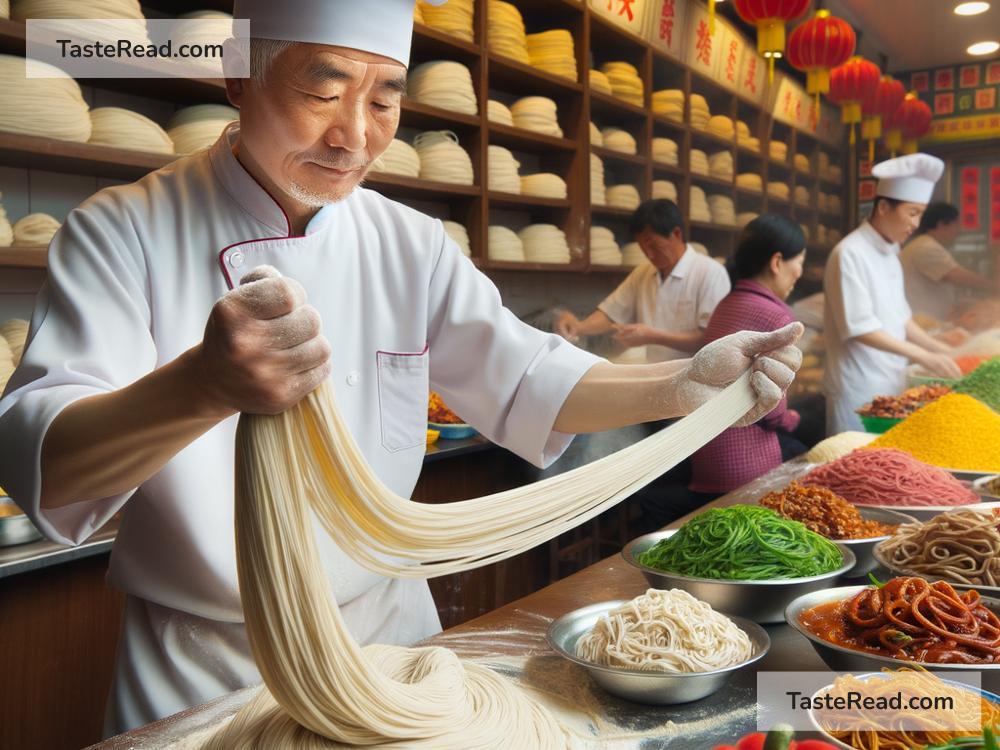Celebrating the Cultural Craft of Hand-Pulled Noodles in Lanzhou, China
Food is an important part of culture, and every region has its own special dishes that tell a story. In Lanzhou, a city in northwest China, one of the most famous dishes is Lanzhou hand-pulled noodles, also known as “Lanzhou lamian.” This delicious noodle soup is not just a meal; it’s a cultural treasure that has been celebrated for centuries. Lanzhou hand-pulled noodles are a perfect example of the harmony between food, art, and tradition.
What Are Lanzhou Hand-Pulled Noodles?
Lanzhou hand-pulled noodles are freshly made wheat noodles that are stretched by hand into long, thin strands. These noodles are cooked in a flavorful beef broth and served with sliced beef, chili oil, green onions, and a special touch of daikon radish. The dish is known for its “five colors”: clear broth, white radish, green herbs, red chili oil, and golden noodles. Together, these colors make the dish visually appealing and even more inviting to eat.
Many people love Lanzhou noodles not only because of their taste but also because of the skill it takes to make them. Pulling these noodles is an amazing craft that requires effort, focus, and years of practice to master.
The Art of Noodle-Making
The process of making Lanzhou hand-pulled noodles is as fascinating as the dish itself. The noodle master starts with a simple dough made of flour, water, and sometimes a small amount of oil or salt. Then, the magic begins. Using only their hands, the master stretches and pulls the dough into even strands. With each pull, the number of noodle strands multiplies, becoming thinner and thinner until they are perfect for cooking.
There’s no cutting in the process—just pulling and stretching. If the dough is too soft, it will break. If it’s too hard, it won’t stretch correctly. This balance is where the master’s skill shines. Watching a noodle master at work is like watching a performance. Their movements are smooth and precise, and the transformation of a lump of dough into a bowl of beautiful noodles feels almost magical.
A Tradition with History
Lanzhou noodles have a long history that dates back over 100 years. This traditional dish has been passed down through generations, and it reflects the blending of cultural influences in the region. Lanzhou is located along the ancient Silk Road, a trade route that connected China to Central Asia and the Middle East. Over time, people in Lanzhou learned new cooking techniques and mixed flavors from different cultures, creating the distinctive noodle soup we know today.
One key figure in the history of Lanzhou noodles is Ma Baozi, a Hui Muslim chef said to have perfected the recipe in 1915. The Hui people, a Chinese Muslim ethnic group, have contributed greatly to the development of Lanzhou’s food culture. Through their influence, the dish gained unique features, such as the use of halal beef and fresh herbs.
Today, Lanzhou noodles are enjoyed not only in China but around the world, bringing people together through food.
Why Lanzhou Noodles Matter
Lanzhou hand-pulled noodles are more than just a popular street food. They represent culture, history, and craftsmanship. In many ways, this dish shows how food can tell a story—about where it comes from, who makes it, and how it connects people.
The making of Lanzhou noodles is a symbol of dedication and skill. It’s a reminder of the importance of preserving traditional methods in the fast-paced, modern world. As machines and factories increasingly take over food production, handmade dishes like Lanzhou noodles show the beauty of slowing down and working with care.
For locals, Lanzhou noodles are a source of pride. For visitors, the dish offers a chance to experience the city’s authentic flavors and culture. Sitting at a noodle shop in Lanzhou and watching a master pull noodles is an unforgettable experience. It’s a moment where you witness history, creativity, and passion all in one bowl.
How to Enjoy Lanzhou Hand-Pulled Noodles
If you ever visit Lanzhou, trying hand-pulled noodles is essential. You’ll find noodle shops throughout the city, each serving fresh, hot bowls of this iconic dish. These shops often have an open kitchen where you can watch the chefs pull noodles right in front of you. Locals usually enjoy the dish in a casual setting, slurping the noodles with chopsticks and savoring the rich broth.
Even if you can’t visit Lanzhou, Lanzhou noodle restaurants have spread to cities all over the world. These restaurants aim to keep the authentic taste alive, giving people everywhere a chance to connect with Chinese food culture.
Conclusion
Lanzhou hand-pulled noodles are much more than food—they’re a story of tradition, skill, and cultural exchange. From the careful art of pulling the noodles to the colorful, flavorful bowl of soup, this dish represents the heart of Lanzhou. It reminds us how deeply food is tied to identity and heritage.
Whether you’re a food lover, a traveler, or someone who simply enjoys learning about different cultures, Lanzhou hand-pulled noodles are worth celebrating. They teach us that even simple ingredients can create something extraordinary when paired with passion and craftsmanship. So, the next time you hold a bowl of Lanzhou noodles, remember: you’re not just eating. You’re experiencing history.


